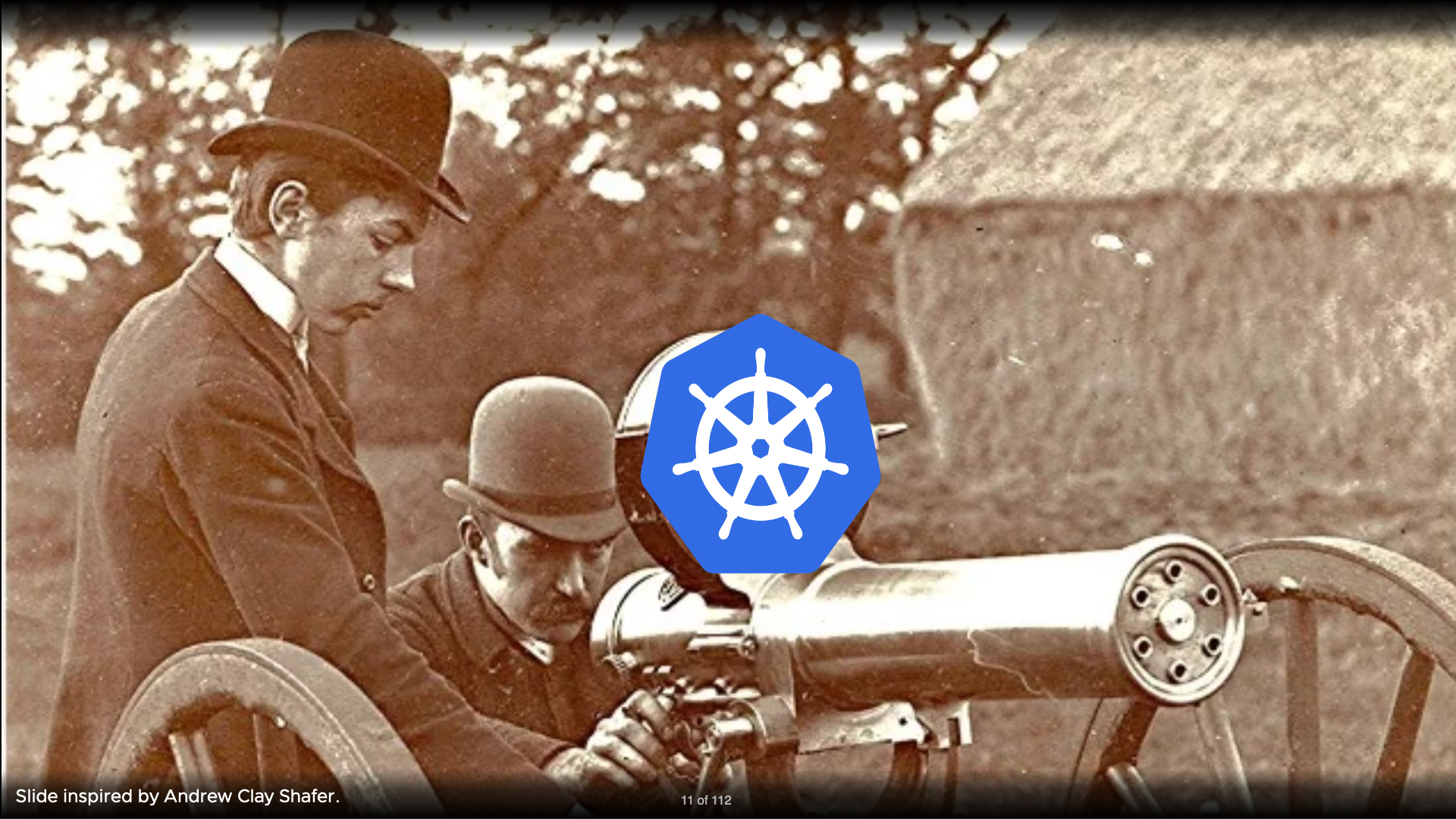
How big the Kubernetes market?
TAM-time for managing Kubernetes:
The container management market has grown more than 20% over the past year, with a market value of over $2.5 billion in 2024. The market is forecast to exceed $4.5 billion in constant currency by 2028, with a 17.6% compound annual growth rate (CAGR). Gartner, August, 2025.
That TAM means that every vendor looking to sell Kubernetes is competing for slice of $3bn to $4bn pie. So, take the marketshare of Amazon, Microsoft Azure, Google Cloud, Oracle Cloud, IBM Red Hat, VMware, and nine other vendors that made the MQ cut. Assume that the top three have something like 30% o 40% of the market divided among them. Then the next three have 15% to 20% divided among them. And the remaining nine divide up 10% to 14% of the market.
Doesn’t sound like a lot of revenue per vendor unless you’re way on top.
Now, you could say “but Kubernetes drives all sorts of other product/service usage.” Indeed! You could say that.
Also, what exactly is “container management”? It is this:
Container management automates the provisioning, operation and life cycle management of containerized workloads at scale. Centralized governance and security policies are used to manage container workloads and associated resources. Container management supports the requirements of modern applications (also refactoring legacy applications), including platform engineering, cloud management and continuous integration/continuous delivery (CI/CD) pipelines. Benefits include improved agility, elasticity and access to innovation.
Also, I suppose if you sold just a Kubernetes distro but not tools to manage it, that would cash would not be included. And, then there’s paying just to run Kubernetes, whether in public cloud or in things like VMware/VCF. But, that might count as “operation.” There are also components for Kubernetes you might sell: storage, networking. There are more pies!
I confess I didn’t spend a lot of time figuring this all out.
App Share
How many apps run on Kubernetes versus other types of infrastructure (VMs, public or private cloud; bare metal; mainframes, etc.)?
Some numbers by AI workloads:
“By 2028, 95% of new AI deployments will use Kubernetes, up from less than 30% today.” Gartner, August, 2025.
Back in Dec, 2024: “by 2027, more than 75% of all AI/ML deployments will use container technology as the underlying compute environment, which is a major increase from fewer than 50% in 2024.” Gartner, December, 2024.
How about apps/workloads in general? This is a very difficult number to find.
I found this number back in August, 2023, but the link to the Gartner source is busted:
“By 2027, 25% of all enterprise applications will run in containers, an increase from fewer than 10% in 2021.” Gartner, can’t find original.
About two years back, one infrastructure analyst I talked with estimated that 10% to 20% of apps ran on Kubernetes.
Here is what the robots think:
ChatGPT 5: “So maybe 10% to 20% of apps globally are running on Kubernetes, with the rest on VMs, bare-metal, other cloud platforms.”
Claude Sonnet 4: “Based on the available data, I’d estimate something like this for production enterprise applications globally:…Containers (mostly Kubernetes): 30% to 40%…Traditional VMs: 50% to 60% // Bare metal: 5% to 10%…Serverless/PaaS: 5% to 10%…The container percentage is growing rapidly (probably 15–20% annually), while VM usage is slowly declining but still dominant in large enterprises with legacy applications.”
Each did a search for surveys and came up with a model. The robots can’t find (or don’t like to find) the likes of Gartner and IDC, so they often pull from some weird sources.

Original Content
Some things I’ve made since last time:
YOLO acquisitions, Software Defined Talk #537: “This week, we dig into Atlassian buying The Browser Company, whether Pay Per Crawl makes sense, and Oracle’s cloud jackpot. Plus, a quick lesson in Aussie slang.”
What Platform Engineers Need to Know about GenAI Security and Compliance, video interview: “AI is a new workload for many platform engineers, developers, security people, and, well, just about everyone. When it comes to minding security and compliance needs, what needs to get done? In this discussion, Coté talks with Chris Cropper and David Zendzian about just this. Chris draws on his experience working with the US military's Software Factory, and David draws from his long history in security. Among other things, they talk about how AI can enhance cybersecurity practices, the significance of continuous compliance, and the necessity of legal and security oversight.”
If you can’t be bothered to watch a lot, here is a short video from that interview.
Relative to your interests
Goldman Sachs bankers explore limits of AI: ‘The risk is over-reliance’ - Some enterprise uses of AI. In this case, it feels like it’s all just using a chat app integrated with data - if even that! “Goldman rolled out its generative AI-powered platform – GS AI Assistant – to all its roughly 46,000 employees in June, telling staff the aim was for it to help with tasks such as summarising complex documents, drafting content and performing data analysis.” And: “They offer enormous efficiency gains, such as drafting documents for an initial public offering in minutes that previously would have taken months, or quickly sketching out a multiyear investment plan. But they can lack the personal nuance that is crucial in a demanding client service business such as banking, which commands multimillion-dollar fees.” Also: “So far she says AI has helped her do her job in four key ways: getting quick answers to complex technical questions; summarising the key points within dense documents; editing and polishing her own written work; and brainstorming. Time saved can be spent with colleagues and clients.”
Agents show promise, but widespread usage in the enterprise remains elusive - "A PwC survey of 300 executives in May found: ‘Almost nine out of 10 executives surveyed (88%) say their companies plan to up their AI-related budgets this year due to agentic AI.” Yet, in spite of this optimism, 68% of respondents said that “half or fewer of their employees interact with agents in their everyday work.’ While 35% reported broad adoption, most companies are not using agentic AI at scale. PwC also found that 18% weren’t using agents at all—a state the report authors called completely lacking in vision.” // In 2026, I’d like to see a lot more coverage about the actual enterprise AI apps people are building and running.
The Last Days Of Social Media - If true, this is probably great. Obvs people engaging with each other - with strangers - on social media is too risky for society: “People aren’t connecting or conversing on social media like they used to; they’re just wading through slop, that is, low-effort, low-quality content produced at scale, often with AI, for engagement.” (Via Russel Davies.)
How the Sun Microsystems acquisition made Oracle the cloud company it is today
Spring AI 1.1.0-M1 Available Now - Looks like great additions for MCP.
The Untold Saga of What Happened When DOGE Stormed Social Security - An IT modernization tale, with both technology and culture. Lots of crazy tales and quotes, as you’d expect from a saga that involves a character named “Big Balls.” Meanwhile:
Why CIOs can’t afford another modernization failure in 2026 - ”Gartner estimates that up to 70% of large-scale digital transformation and modernization initiatives fail to deliver their intended outcomes. That number has hovered stubbornly high for years, but the stakes in 2026 are different.”
How our Edge Kubernetes Platform has Evolved - Update on the Chick-fil-a Kubernetes, edge stuff.
AirPods Live Translation Blocked for EU Users With EU Apple Accounts - “won’t be available if both the user is physically in the EU and their Apple Account region is in the EU.”
Gabe Rivera’s 20-year-old headline site, Techmeme, has never been hotter. - “Today the only full time employees besides him are Horvitz and two full time editors. The rest of the staff – a book keeper and the remaining 23 editors – are part time working remotely in enough different time zones to supply Techmeme and Mediagazer with near 24×7 coverage.”
Cracker Barrel halts remodels after logo backlash, lackluster test - If your deal is nostalgia for another time (imagined on real), your customers are likely conservative regarding modernizing. They want things to stay the same, the job to be done, brand wise, is a nostalgia experience. Hopefully the food has good price/performance too.
Wastebook
“I couldn’t imagine anything worse than running my dad’s Hooters.” Matthew Prince.
“Chicken-fried gravy steak.”
“Music for Claude Coding.” Long pauses.
“I was drinking coffee because I was tired, and I was tired because I was drinking coffee. Can not drinking nearly two liters of coffee every day improve your sleep quality? Big if true.” Less Coffee, Better Sleep.
This is the kind of thing the Internet was made for, with that “one person can do a thing” vibe. Plus, this is the kind of music I go nuts for.
"The last thing I bought and loved was a sauna. It came on a truck from Sweden. It looks like a little troll barrel and I have it in my garden by one of the two lakes. It’s admittedly a faff, because you have to build a fire, then come back in the house and wait for it to heat up. But there’s nothing else to do where I live, in Northamptonshire. And it’s nice when people stay, because it means there is an activity to break up the wine drinking.” // And: “enforced gift giving around Christmas and birthdays is a bourgeois horror.” Edie Campbell’s supermodel secret[s]

Conferences
VMUG London, speaking, September 18th, speaking. SREDay London, speaking, September 18th and 19th. Civo Navigate London, September 30th, London, speaking. Cloud Foundry Day EU, Frankfurt, October 7th, 2025, speaking. AI for the Rest of Us, London, October 15th to 16th, London, speaking. SREDay Amsterdam, November 7th, speaking.
I’ve got a 20% off discount for AI for the Rest of Us: SDI20. You should go the conference if you can, it’ll be good!
Logoff
After interviewing Manton Reece for Software Defined Interviews,1 last week, I started looking back into using micro.blog more.2 That’s where I host my blog and home page on the World Wide Web. I’ve been posting links (the ones you find here!) in there, old-school blogger style. I’ve now got it setup to put wastebook entries in there, and have been posting some other things. Check it out if you really want the dual-firehose (it’s got RSS too, of course).
I migrated my Mastodon account to just use micro.blog’s thing. It’s sort of a weird Mastodon implementation: you don’t get the standard Mastodon UI. You know, I get a lot of “engagement” in Maston, but I don’t really feel like I’ve figured out how to be a consumer in that community. Also, I added back in Threads cross-posting: people started liking stuff a lot in that place!
Anyhow. I’m still posting most all my stuff, including links, in all the places. The newsletter, here, then, is like a digest of all that.
//
I’ve been figuring out how to make fatteh, three of the attempts pictured above. As with many dishes, it seems there is no one, true way to make it. I’m trying to make one that I like. I started roasting the pine-nuts in ghee, and that is too much. I switched to using the air fryer to make the pita chips (related), and that’s nice. In the last attempts I think I cracked it (for my tastes, at least): roasted the pine-nuts in chili infused olive oil. I have not made it with ground lamb (nor beef). That seems like it’d be awesome, what with all the lamb-y grease.
//
Thank you for reading my newsletter. It appears either in your email, my blog, or your RSS feeds.
To be published Oct 15th. Subscribe to get it then, plus two other shows in between now and then. Also, the whole back-catalog.
My pal Robert Brook summarizes why to use micro.blog over others well: “I trust Manton’s choices.” Something like that, at least. Manton is always trying out new things in new ways. A good tinkerer.
